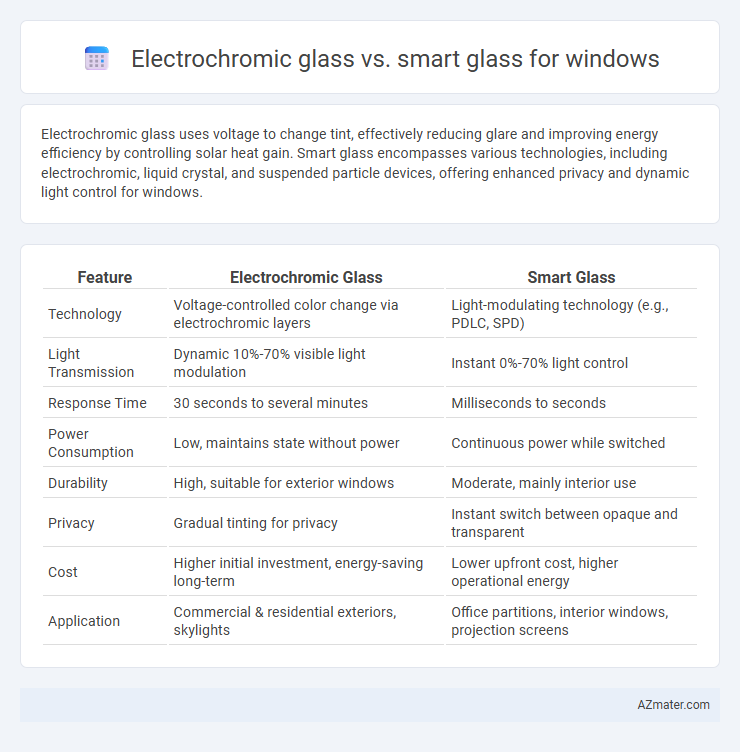Electrochromic glass uses voltage to change tint, effectively reducing glare and improving energy efficiency by controlling solar heat gain. Smart glass encompasses various technologies, including electrochromic, liquid crystal, and suspended particle devices, offering enhanced privacy and dynamic light control for windows.
Table of Comparison
| Feature | Electrochromic Glass | Smart Glass |
|---|---|---|
| Technology | Voltage-controlled color change via electrochromic layers | Light-modulating technology (e.g., PDLC, SPD) |
| Light Transmission | Dynamic 10%-70% visible light modulation | Instant 0%-70% light control |
| Response Time | 30 seconds to several minutes | Milliseconds to seconds |
| Power Consumption | Low, maintains state without power | Continuous power while switched |
| Durability | High, suitable for exterior windows | Moderate, mainly interior use |
| Privacy | Gradual tinting for privacy | Instant switch between opaque and transparent |
| Cost | Higher initial investment, energy-saving long-term | Lower upfront cost, higher operational energy |
| Application | Commercial & residential exteriors, skylights | Office partitions, interior windows, projection screens |
Introduction to Electrochromic and Smart Glass Technologies
Electrochromic glass uses an applied electrical voltage to change its tint, offering dynamic control over light transmission and energy efficiency in building windows. Smart glass technologies include various methods such as electrochromic, photochromic, and thermochromic, but electrochromic remains the most widely adopted for its reversible and precise light modulation. Both technologies enhance occupant comfort and reduce HVAC loads by managing solar heat gain and glare without compromising natural daylight.
How Electrochromic Glass Works
Electrochromic glass functions by applying a small electrical voltage that triggers a reversible chemical reaction within its multiple layers, changing the glass's tint to control light and heat transmission. This technology consists of transparent electrodes, an electrochromic layer, an ion conductor, and a counter electrode, facilitating the movement of ions and electrons to modulate opacity. Unlike some smart glass technologies that rely on liquid crystals or suspended particles, electrochromic glass offers gradual and energy-efficient tint adjustments for enhanced comfort and energy savings.
How Smart Glass (SPD/PDLC) Operates
Smart glass utilizing Suspended Particle Device (SPD) or Polymer Dispersed Liquid Crystal (PDLC) technology operates by controlling light transmission through electrical stimuli. SPD glass modulates the alignment of suspended particles within the film to adjust opacity, while PDLC glass changes the orientation of liquid crystal molecules to switch between opaque and transparent states. These dynamic adjustments enhance energy efficiency and privacy by precisely managing solar heat gain and daylight without mechanical blinds.
Key Differences Between Electrochromic and Smart Glass
Electrochromic glass changes its tint through a low-voltage electrical charge, offering energy efficiency by controlling solar heat gain and glare. Smart glass, including electrochromic but also technologies like suspended particle and liquid crystal, provides dynamic light modulation with varied switching speeds and control methods. Key differences lie in response time, cost, and application, with electrochromic glass favored for its durability and gradual transition compared to faster but often more expensive smart glass variants.
Energy Efficiency Comparison
Electrochromic glass offers precise control over solar heat gain by gradually tinting windows, significantly reducing cooling loads and enhancing energy efficiency in buildings. Smart glass technologies, including electrochromic and other variants like thermochromic or photochromic, adapt dynamically to environmental conditions, optimizing natural light and minimizing the need for artificial lighting and HVAC energy consumption. Electrochromic glass typically outperforms other smart glass types in long-term energy savings due to its stable, low-energy switching mechanism and effective thermal insulation properties.
Privacy and Light Control Capabilities
Electrochromic glass offers precise light control by electronically adjusting transparency levels to enhance privacy and reduce glare, making it ideal for environments requiring variable shading. Smart glass technologies, including suspended particle devices and polymer dispersed liquid crystals, provide rapid switching between opaque and transparent states for on-demand privacy. Both technologies improve energy efficiency by controlling solar heat gain, but electrochromic glass excels in gradual tint adjustments, whereas smart glass delivers instant privacy control.
Installation and Maintenance Considerations
Electrochromic glass installation requires precise electrical wiring and integration with control systems, often necessitating professional expertise to ensure optimal functionality and longevity. Maintenance for electrochromic glass is minimal but may involve occasional calibration of the tinting mechanism to preserve uniform performance. In contrast, smart glass, such as polymer-dispersed liquid crystal (PDLC) systems, typically involves simpler installation processes but may require periodic replacement of control electronics or films to maintain clarity and responsiveness.
Cost Analysis and Long-Term Value
Electrochromic glass typically incurs higher upfront costs due to advanced materials and manufacturing complexity, but delivers substantial energy savings by dynamically controlling solar heat gain, resulting in lower cooling expenses over time. Smart glass options, including polymer-dispersed liquid crystal (PDLC) variants, often have lower initial investments but may require more frequent replacements or maintenance due to faster component degradation, impacting total cost of ownership. Long-term value favors electrochromic glass for commercial buildings emphasizing energy efficiency and sustainability, while smart glass suits applications prioritizing adaptable privacy and lower initial expenditure.
Applications in Residential and Commercial Buildings
Electrochromic glass offers precise control over light transmission, making it ideal for energy-efficient residential windows by reducing glare and heat gain. Smart glass, encompassing technologies such as liquid crystal and suspended particle devices, provides rapid switching capabilities suited for commercial buildings requiring dynamic privacy or conference room partitioning. Both technologies enhance occupant comfort and energy savings but differ in switching speed and application specificity.
Which Technology Is Better for Your Windows?
Electrochromic glass offers precise tint control through reversible chemical reactions, enabling gradual shading to reduce glare and improve energy efficiency. Smart glass technologies, including polymer-dispersed liquid crystal (PDLC) and suspended particle devices (SPD), provide instant switchable opacity for privacy on demand but may consume more power. Choosing the better technology depends on needs for energy savings, privacy, response time, and budget constraints, with electrochromic glass ideal for dynamic daylight management and smart glass suited for quick privacy control.

Infographic: Electrochromic glass vs Smart glass for Window
 azmater.com
azmater.com